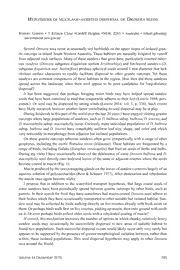
Hypothesis of mucilage-assisted dispersal of Drosera seeds PDF
Preview Hypothesis of mucilage-assisted dispersal of Drosera seeds
Hypothesis of mucilage-assisted dispersal of Drosera seeds Robert Gibson • 5 Kristen Close ‘Cardiff Heights *NSW, 2285 • Australia • robert.gibson@ environment.nsw.gov.au Several Drosera taxa occur in seasonally wet herbfields on the upper slopes ofisolated gran- ite outcrops in inland South Western Australia. These habitats are naturally irrigated by runoff from adjacent rock surfaces. Many ofthese sundews that grow here, particularly rosetted tuber- ous sundews {Drosera subgenus Ergaleium section Erythrorhiza) and fan-leaved sundews (D. mm subgenus Ergaleium sect. Stolonifera) produce spherical seeds around 1 diameter that lack obvious surface characters to readily facilitate dispersal to other granite outcrops. Yet these sundews are common components ofthese habitats in the region. How then did these sundews spread across the landscape when their seed appear to be poor candidates for long-distance dispersal? It has been suggested that perhaps foraging water birds may have helped spread sundew seeds that have been entrained in mud that temporarily adheres to their feet (Lowrie 1988, pers. comm.). Or seed may be dispersed by strong winds (Lowrie 2014: vol. 1, p. 338). Such events have likely occurred, however another factor contributing to seed dispersal may be at play. During fieldwork inthispart ofthe world overthe last20 years I have enjoyedvisiting granite outcrops where large populations ofsundews, such asD. bulbosa subsp. bulbosa, D. lowriei, and D. macrophylla subsp. macrophylla occur. Curiously many individual populations ofD. bulbosa subsp. bulbosa and D. lowriei have remarkably uniform leaf size, shape, and color and which vary noticeably in morphology from adjacent but isolated populations. On these granite outcrops tuberous sundews often grow sympatrically with a range ofother geophytes, including the exotic Romulea rosea (Iridaceae). These habitats are frequented by a range ofbirds, including Galahs Eolophus roseicapilla) that feed on seeds ofherbs and bulbs. ( During my visits I have occasionally observed the dehiscence ofsome Drosera bulbosa and D. macrophylla seed directly onto bedewed leaves ofthe same or adjacent rosettes where the seeds become coated in mucin (Fig. 1). Mucin producedby the insect-trapping glands onthe leaves ofsundews consists largely ofan & aqueous solution ofpolysaccharides (Rost Schauer 1977). After desiccation and rehydration the mucin once-again become sticky. I propose that in addition to the water-bird transport hypothesis, that large round seeds of some sundews have been periodically spread between granite outcrops by other birds, such as parrots. In their search for food they have sometimes had mucin-coated Drosera seed adhere to theirbodies which they have occasionally transportedto other suitable but isolated habitat. Sun- dew seed may be collected by birds walking directly on live rosettes already with fresh seeds on them. Orperhaps birds walkfirst on live rosettes, pickingup mucin, thenonto groundwith seeds on it. Or even perhaps birds collect older seeds with a rehydrated coating ofmucin? Ifcorrect, this mechanism increases the number ofoptions in which chunky, relativelyheavy sundew seeds may occasionally be successfully dispersed to new areas of suitable habitat to foundnewpopulations. Such successful dispersal events would likely occur only veryrarely but appears to be supportedby the presence ofgreatermorphological variation between, ratherthan within, these isolated populations. This seed dispersal hypothesis may apply to other Drosera taxa around the World. Volume 44 December 2015 195 Figure 1: Drosera bulbosa subsp. bulbosa (and D. glanduligera) on a granite outcrop near Hyden. Some seed has been shed directly onto active leaves. Acknowledgement: I thank Allen Lowrie for discussions on the subject ofDrosera dispersal that have kept me thinking about this interesting topic. References Lowrie,A. 2014. Carnivorous Plants ofAustralia: MagnumOpus. RedfernNatural HistoryProduc- tions, Poole. Rost, K., and Schauer, R. 1977. Physical and chemicalproperties ofthemucin secretedbyDrosera capensis. Phytochemistry 16: 1365-1368. WWW.CZPLANTS.COM .e & carnivorous exotic plants Si m & Bp! M n i r, $84 4 & : & V 196 Carnivorous Plant Newsletter
